University Brand Management Report: Aaker's Model Analysis
VerifiedAdded on 2020/05/28
|14
|3181
|80
Report
AI Summary
This report provides a comprehensive analysis of brand management, focusing on Aaker's Brand Identity Model (ABIM). It begins by discussing how organizations establish their brands, emphasizing the concept and significance of brand identity, and differentiates it from brand image. The core of the report is an in-depth examination of ABIM, exploring its perspectives: brand as a product, organization, person, and symbol. The report compares ABIM with Keller's model, highlighting the differences in their approaches to branding. Each perspective of ABIM is analyzed in detail, providing examples and insights into how brands can leverage these elements to build brand equity and achieve a competitive advantage. The report provides a clear understanding of how different aspects of brand identity contribute to brand success, making it a valuable resource for students studying marketing and brand management.

Running head: BRAND MANAGEMENT
Brand Management
Name of Student
Name of University
Author Note
Brand Management
Name of Student
Name of University
Author Note
Secure Best Marks with AI Grader
Need help grading? Try our AI Grader for instant feedback on your assignments.
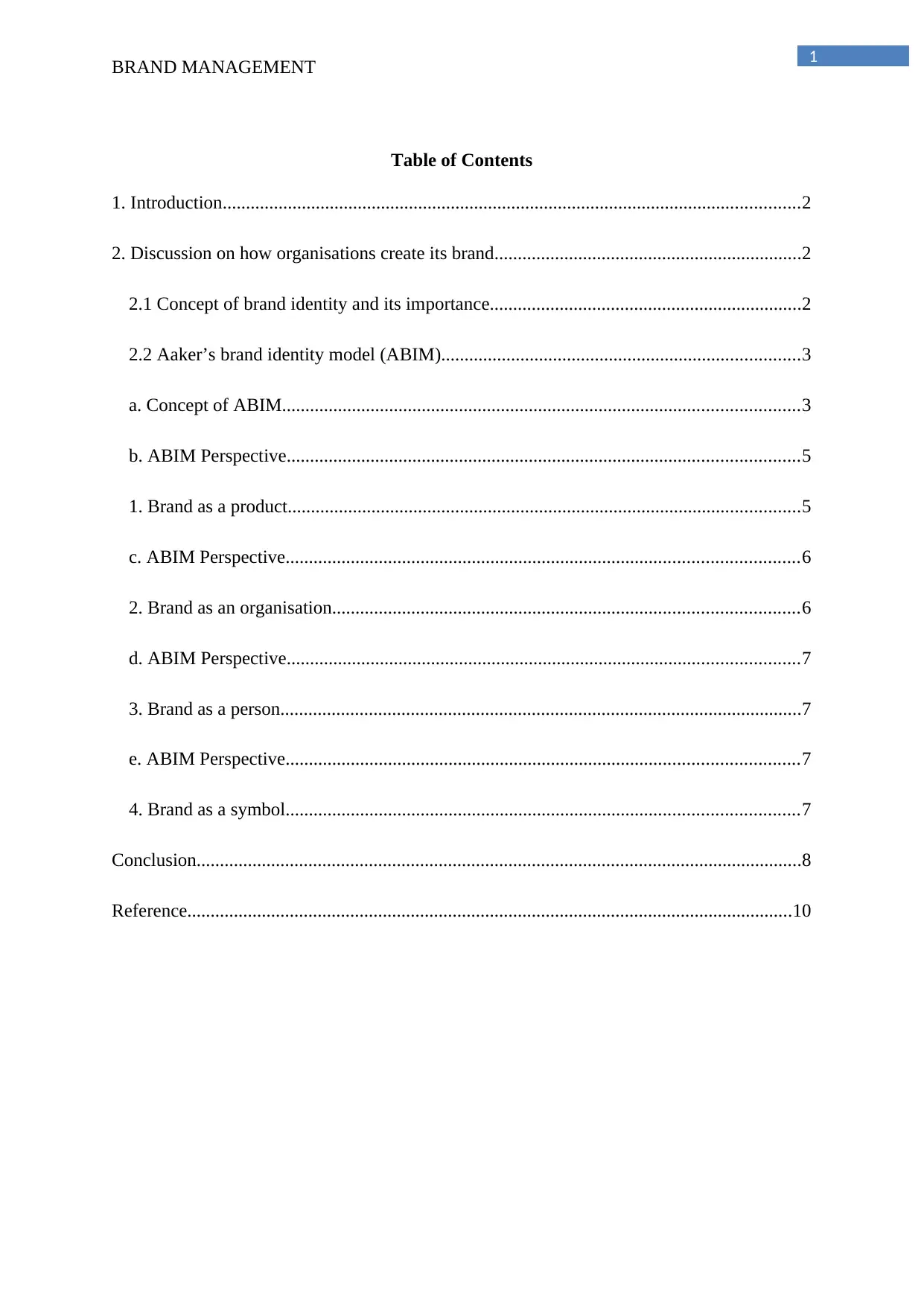
1
BRAND MANAGEMENT
Table of Contents
1. Introduction............................................................................................................................2
2. Discussion on how organisations create its brand..................................................................2
2.1 Concept of brand identity and its importance...................................................................2
2.2 Aaker’s brand identity model (ABIM).............................................................................3
a. Concept of ABIM...............................................................................................................3
b. ABIM Perspective..............................................................................................................5
1. Brand as a product..............................................................................................................5
c. ABIM Perspective..............................................................................................................6
2. Brand as an organisation....................................................................................................6
d. ABIM Perspective..............................................................................................................7
3. Brand as a person................................................................................................................7
e. ABIM Perspective..............................................................................................................7
4. Brand as a symbol..............................................................................................................7
Conclusion..................................................................................................................................8
Reference..................................................................................................................................10
BRAND MANAGEMENT
Table of Contents
1. Introduction............................................................................................................................2
2. Discussion on how organisations create its brand..................................................................2
2.1 Concept of brand identity and its importance...................................................................2
2.2 Aaker’s brand identity model (ABIM).............................................................................3
a. Concept of ABIM...............................................................................................................3
b. ABIM Perspective..............................................................................................................5
1. Brand as a product..............................................................................................................5
c. ABIM Perspective..............................................................................................................6
2. Brand as an organisation....................................................................................................6
d. ABIM Perspective..............................................................................................................7
3. Brand as a person................................................................................................................7
e. ABIM Perspective..............................................................................................................7
4. Brand as a symbol..............................................................................................................7
Conclusion..................................................................................................................................8
Reference..................................................................................................................................10
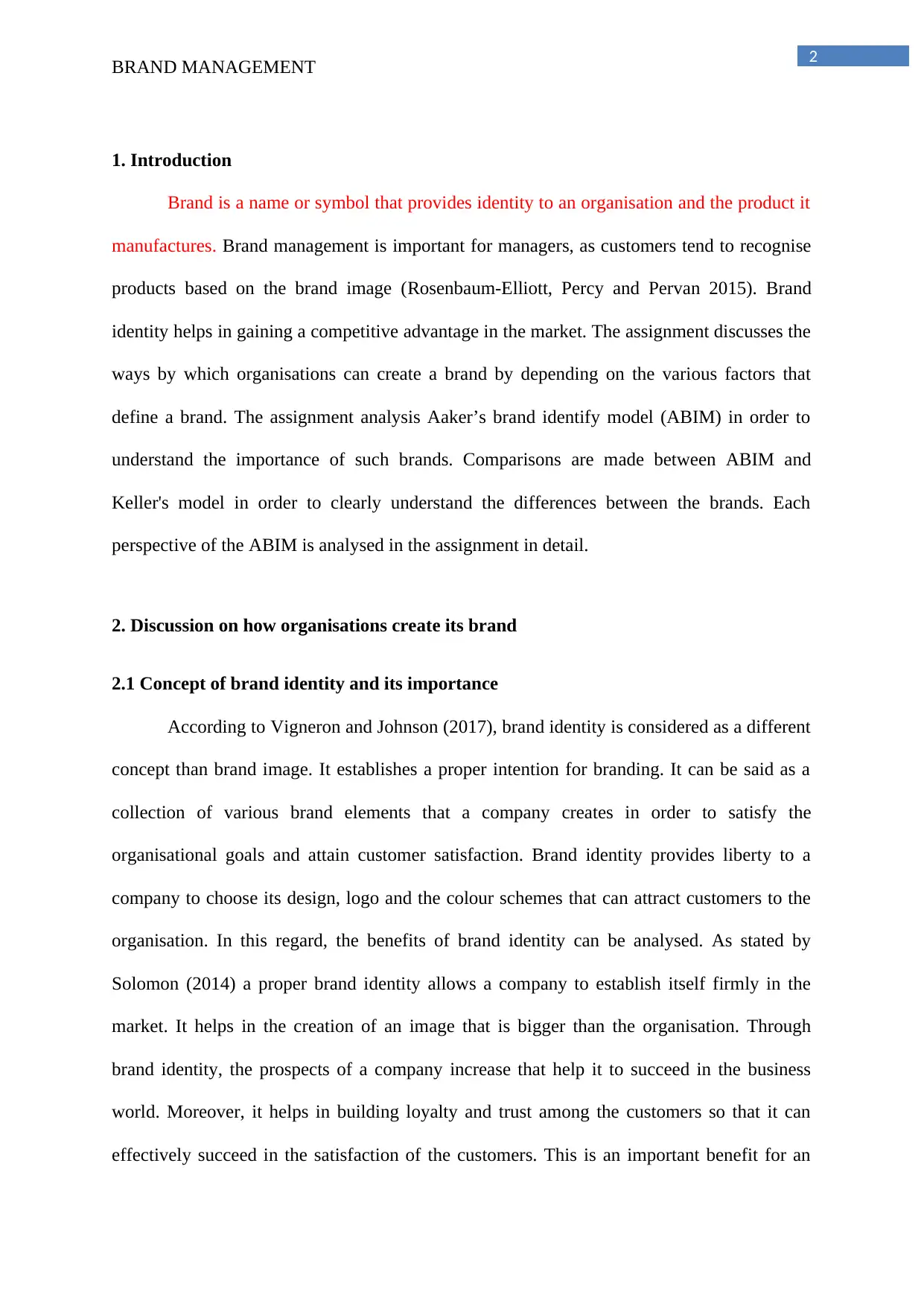
2
BRAND MANAGEMENT
1. Introduction
Brand is a name or symbol that provides identity to an organisation and the product it
manufactures. Brand management is important for managers, as customers tend to recognise
products based on the brand image (Rosenbaum-Elliott, Percy and Pervan 2015). Brand
identity helps in gaining a competitive advantage in the market. The assignment discusses the
ways by which organisations can create a brand by depending on the various factors that
define a brand. The assignment analysis Aaker’s brand identify model (ABIM) in order to
understand the importance of such brands. Comparisons are made between ABIM and
Keller's model in order to clearly understand the differences between the brands. Each
perspective of the ABIM is analysed in the assignment in detail.
2. Discussion on how organisations create its brand
2.1 Concept of brand identity and its importance
According to Vigneron and Johnson (2017), brand identity is considered as a different
concept than brand image. It establishes a proper intention for branding. It can be said as a
collection of various brand elements that a company creates in order to satisfy the
organisational goals and attain customer satisfaction. Brand identity provides liberty to a
company to choose its design, logo and the colour schemes that can attract customers to the
organisation. In this regard, the benefits of brand identity can be analysed. As stated by
Solomon (2014) a proper brand identity allows a company to establish itself firmly in the
market. It helps in the creation of an image that is bigger than the organisation. Through
brand identity, the prospects of a company increase that help it to succeed in the business
world. Moreover, it helps in building loyalty and trust among the customers so that it can
effectively succeed in the satisfaction of the customers. This is an important benefit for an
BRAND MANAGEMENT
1. Introduction
Brand is a name or symbol that provides identity to an organisation and the product it
manufactures. Brand management is important for managers, as customers tend to recognise
products based on the brand image (Rosenbaum-Elliott, Percy and Pervan 2015). Brand
identity helps in gaining a competitive advantage in the market. The assignment discusses the
ways by which organisations can create a brand by depending on the various factors that
define a brand. The assignment analysis Aaker’s brand identify model (ABIM) in order to
understand the importance of such brands. Comparisons are made between ABIM and
Keller's model in order to clearly understand the differences between the brands. Each
perspective of the ABIM is analysed in the assignment in detail.
2. Discussion on how organisations create its brand
2.1 Concept of brand identity and its importance
According to Vigneron and Johnson (2017), brand identity is considered as a different
concept than brand image. It establishes a proper intention for branding. It can be said as a
collection of various brand elements that a company creates in order to satisfy the
organisational goals and attain customer satisfaction. Brand identity provides liberty to a
company to choose its design, logo and the colour schemes that can attract customers to the
organisation. In this regard, the benefits of brand identity can be analysed. As stated by
Solomon (2014) a proper brand identity allows a company to establish itself firmly in the
market. It helps in the creation of an image that is bigger than the organisation. Through
brand identity, the prospects of a company increase that help it to succeed in the business
world. Moreover, it helps in building loyalty and trust among the customers so that it can
effectively succeed in the satisfaction of the customers. This is an important benefit for an
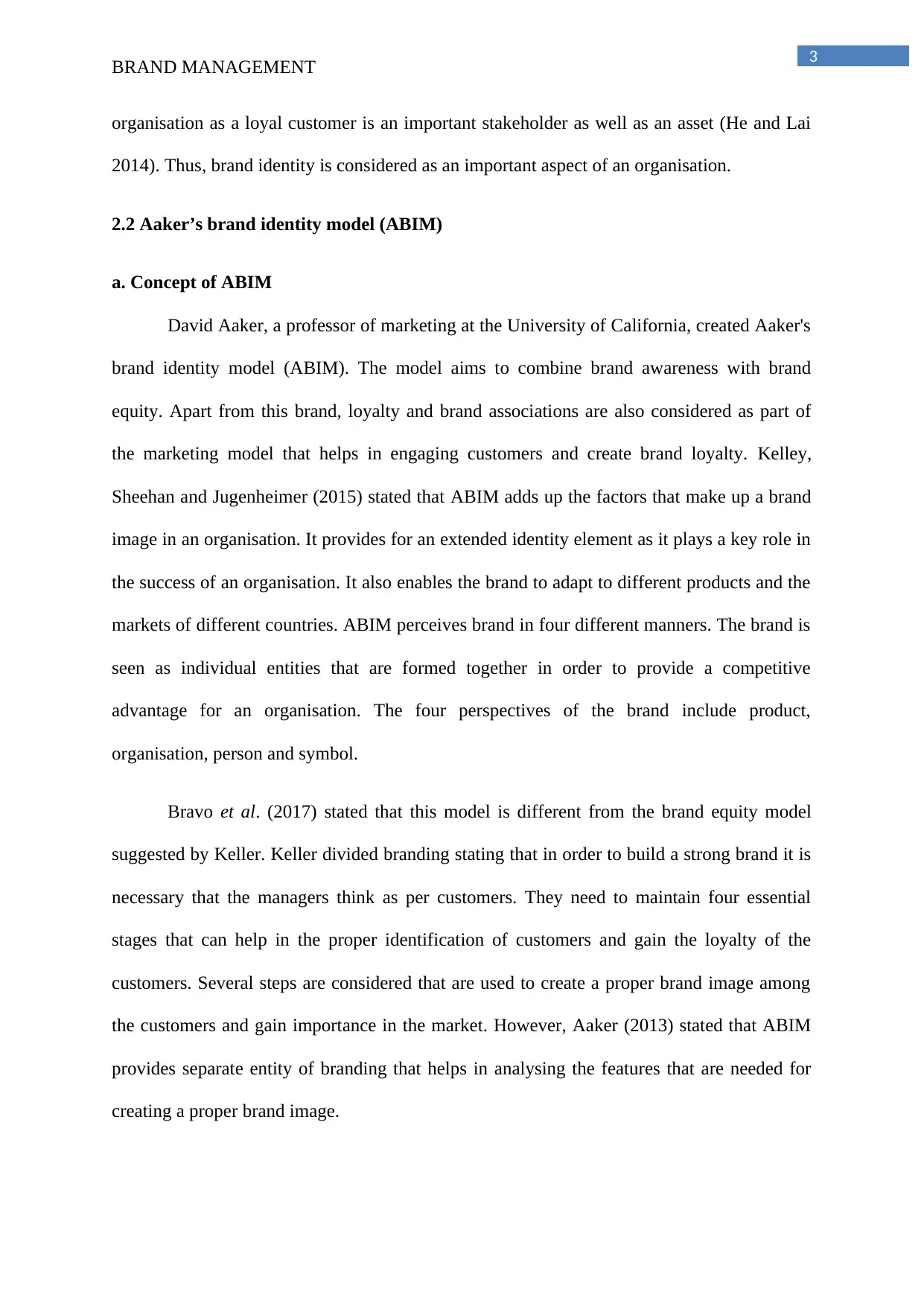
3
BRAND MANAGEMENT
organisation as a loyal customer is an important stakeholder as well as an asset (He and Lai
2014). Thus, brand identity is considered as an important aspect of an organisation.
2.2 Aaker’s brand identity model (ABIM)
a. Concept of ABIM
David Aaker, a professor of marketing at the University of California, created Aaker's
brand identity model (ABIM). The model aims to combine brand awareness with brand
equity. Apart from this brand, loyalty and brand associations are also considered as part of
the marketing model that helps in engaging customers and create brand loyalty. Kelley,
Sheehan and Jugenheimer (2015) stated that ABIM adds up the factors that make up a brand
image in an organisation. It provides for an extended identity element as it plays a key role in
the success of an organisation. It also enables the brand to adapt to different products and the
markets of different countries. ABIM perceives brand in four different manners. The brand is
seen as individual entities that are formed together in order to provide a competitive
advantage for an organisation. The four perspectives of the brand include product,
organisation, person and symbol.
Bravo et al. (2017) stated that this model is different from the brand equity model
suggested by Keller. Keller divided branding stating that in order to build a strong brand it is
necessary that the managers think as per customers. They need to maintain four essential
stages that can help in the proper identification of customers and gain the loyalty of the
customers. Several steps are considered that are used to create a proper brand image among
the customers and gain importance in the market. However, Aaker (2013) stated that ABIM
provides separate entity of branding that helps in analysing the features that are needed for
creating a proper brand image.
BRAND MANAGEMENT
organisation as a loyal customer is an important stakeholder as well as an asset (He and Lai
2014). Thus, brand identity is considered as an important aspect of an organisation.
2.2 Aaker’s brand identity model (ABIM)
a. Concept of ABIM
David Aaker, a professor of marketing at the University of California, created Aaker's
brand identity model (ABIM). The model aims to combine brand awareness with brand
equity. Apart from this brand, loyalty and brand associations are also considered as part of
the marketing model that helps in engaging customers and create brand loyalty. Kelley,
Sheehan and Jugenheimer (2015) stated that ABIM adds up the factors that make up a brand
image in an organisation. It provides for an extended identity element as it plays a key role in
the success of an organisation. It also enables the brand to adapt to different products and the
markets of different countries. ABIM perceives brand in four different manners. The brand is
seen as individual entities that are formed together in order to provide a competitive
advantage for an organisation. The four perspectives of the brand include product,
organisation, person and symbol.
Bravo et al. (2017) stated that this model is different from the brand equity model
suggested by Keller. Keller divided branding stating that in order to build a strong brand it is
necessary that the managers think as per customers. They need to maintain four essential
stages that can help in the proper identification of customers and gain the loyalty of the
customers. Several steps are considered that are used to create a proper brand image among
the customers and gain importance in the market. However, Aaker (2013) stated that ABIM
provides separate entity of branding that helps in analysing the features that are needed for
creating a proper brand image.
Secure Best Marks with AI Grader
Need help grading? Try our AI Grader for instant feedback on your assignments.
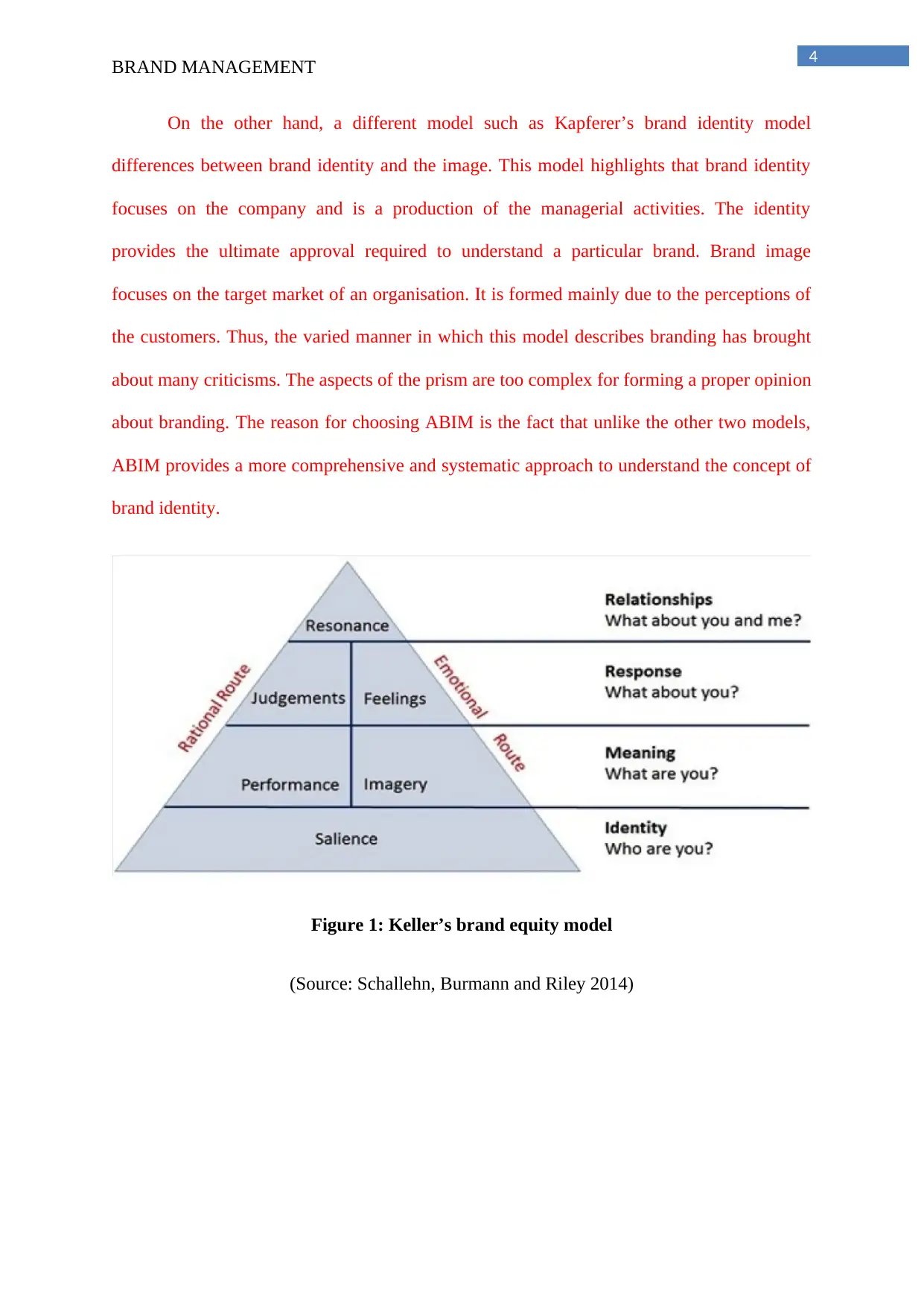
4
BRAND MANAGEMENT
On the other hand, a different model such as Kapferer’s brand identity model
differences between brand identity and the image. This model highlights that brand identity
focuses on the company and is a production of the managerial activities. The identity
provides the ultimate approval required to understand a particular brand. Brand image
focuses on the target market of an organisation. It is formed mainly due to the perceptions of
the customers. Thus, the varied manner in which this model describes branding has brought
about many criticisms. The aspects of the prism are too complex for forming a proper opinion
about branding. The reason for choosing ABIM is the fact that unlike the other two models,
ABIM provides a more comprehensive and systematic approach to understand the concept of
brand identity.
Figure 1: Keller’s brand equity model
(Source: Schallehn, Burmann and Riley 2014)
BRAND MANAGEMENT
On the other hand, a different model such as Kapferer’s brand identity model
differences between brand identity and the image. This model highlights that brand identity
focuses on the company and is a production of the managerial activities. The identity
provides the ultimate approval required to understand a particular brand. Brand image
focuses on the target market of an organisation. It is formed mainly due to the perceptions of
the customers. Thus, the varied manner in which this model describes branding has brought
about many criticisms. The aspects of the prism are too complex for forming a proper opinion
about branding. The reason for choosing ABIM is the fact that unlike the other two models,
ABIM provides a more comprehensive and systematic approach to understand the concept of
brand identity.
Figure 1: Keller’s brand equity model
(Source: Schallehn, Burmann and Riley 2014)
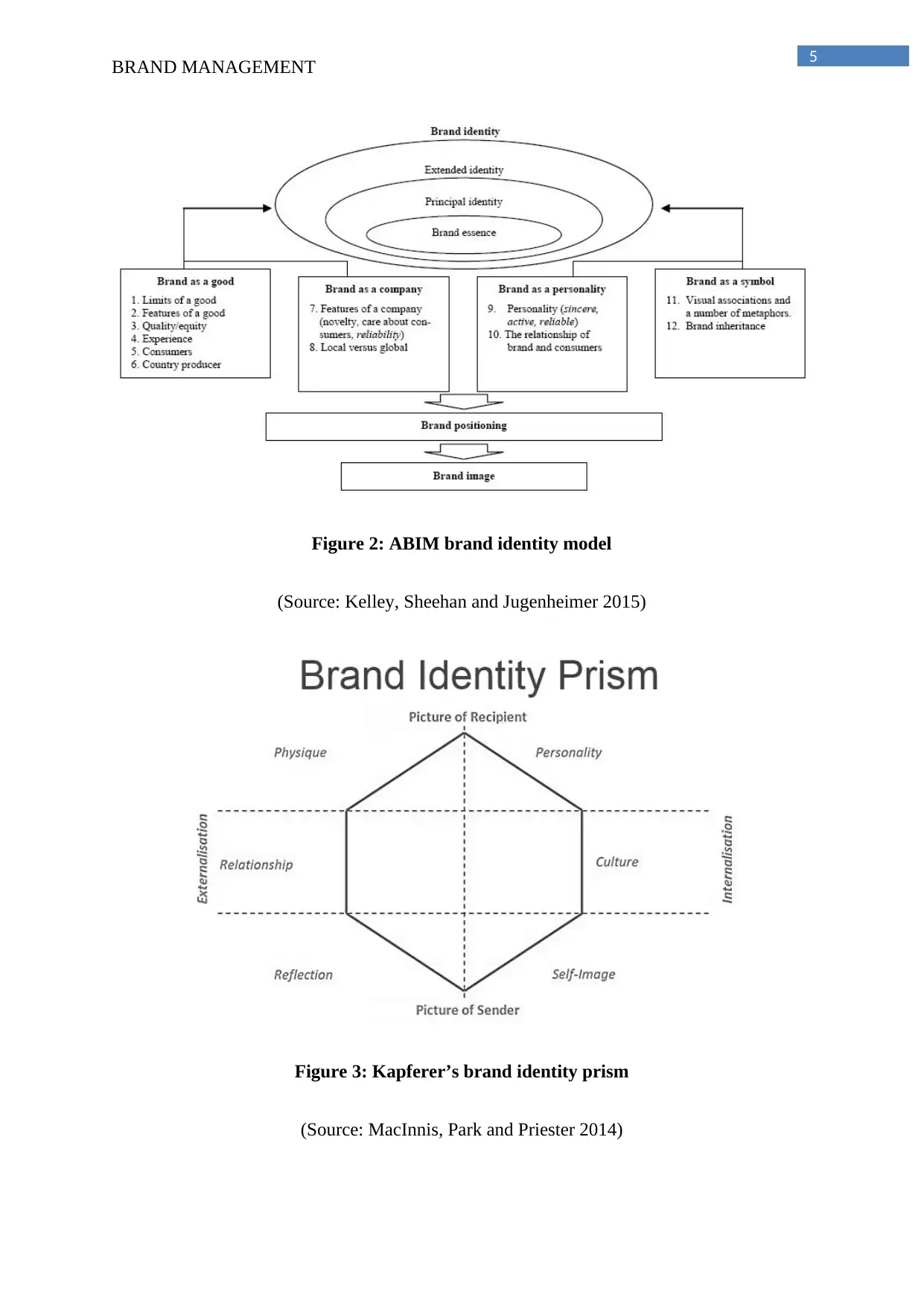
5
BRAND MANAGEMENT
Figure 2: ABIM brand identity model
(Source: Kelley, Sheehan and Jugenheimer 2015)
Figure 3: Kapferer’s brand identity prism
(Source: MacInnis, Park and Priester 2014)
BRAND MANAGEMENT
Figure 2: ABIM brand identity model
(Source: Kelley, Sheehan and Jugenheimer 2015)
Figure 3: Kapferer’s brand identity prism
(Source: MacInnis, Park and Priester 2014)
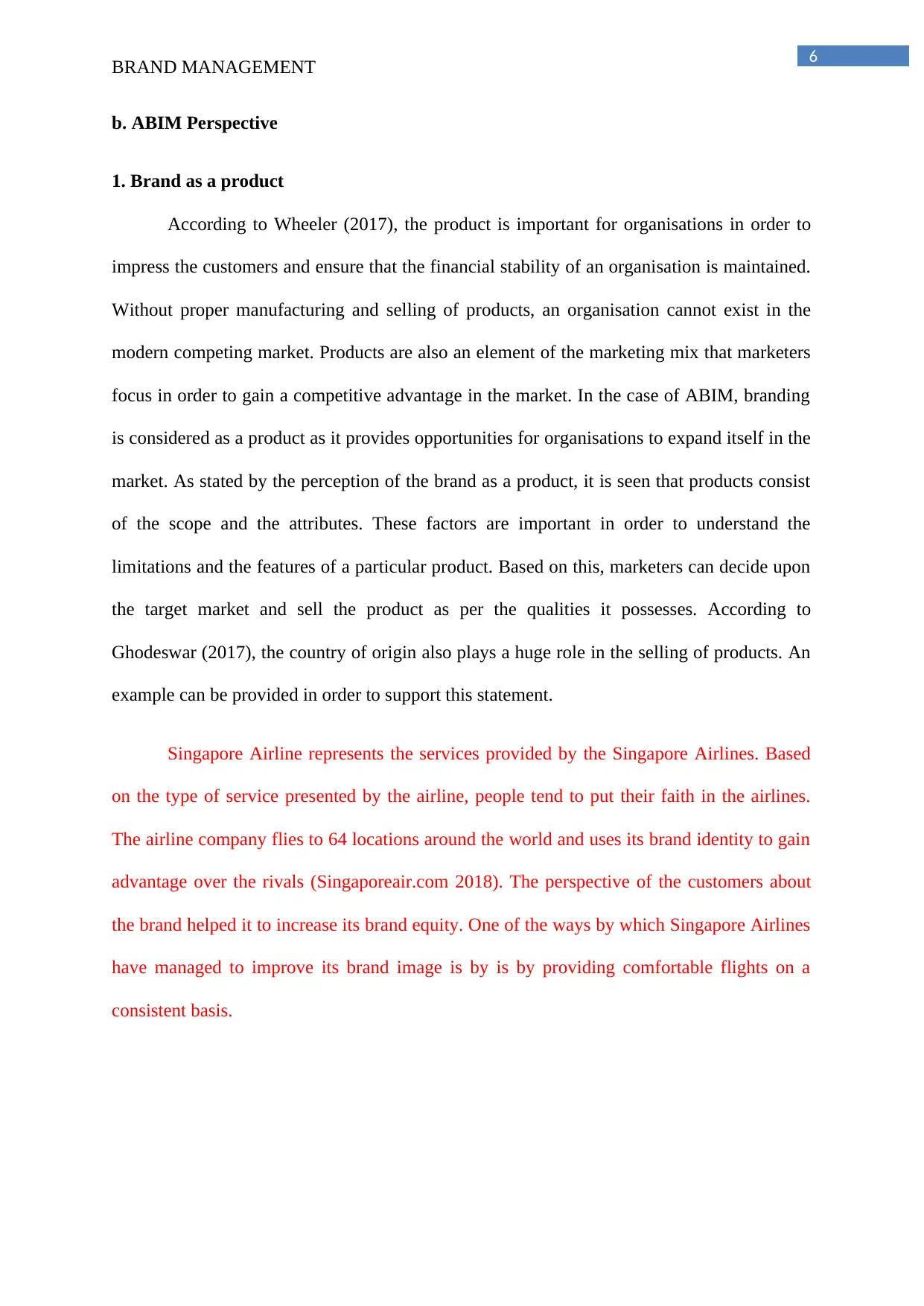
6
BRAND MANAGEMENT
b. ABIM Perspective
1. Brand as a product
According to Wheeler (2017), the product is important for organisations in order to
impress the customers and ensure that the financial stability of an organisation is maintained.
Without proper manufacturing and selling of products, an organisation cannot exist in the
modern competing market. Products are also an element of the marketing mix that marketers
focus in order to gain a competitive advantage in the market. In the case of ABIM, branding
is considered as a product as it provides opportunities for organisations to expand itself in the
market. As stated by the perception of the brand as a product, it is seen that products consist
of the scope and the attributes. These factors are important in order to understand the
limitations and the features of a particular product. Based on this, marketers can decide upon
the target market and sell the product as per the qualities it possesses. According to
Ghodeswar (2017), the country of origin also plays a huge role in the selling of products. An
example can be provided in order to support this statement.
Singapore Airline represents the services provided by the Singapore Airlines. Based
on the type of service presented by the airline, people tend to put their faith in the airlines.
The airline company flies to 64 locations around the world and uses its brand identity to gain
advantage over the rivals (Singaporeair.com 2018). The perspective of the customers about
the brand helped it to increase its brand equity. One of the ways by which Singapore Airlines
have managed to improve its brand image is by is by providing comfortable flights on a
consistent basis.
BRAND MANAGEMENT
b. ABIM Perspective
1. Brand as a product
According to Wheeler (2017), the product is important for organisations in order to
impress the customers and ensure that the financial stability of an organisation is maintained.
Without proper manufacturing and selling of products, an organisation cannot exist in the
modern competing market. Products are also an element of the marketing mix that marketers
focus in order to gain a competitive advantage in the market. In the case of ABIM, branding
is considered as a product as it provides opportunities for organisations to expand itself in the
market. As stated by the perception of the brand as a product, it is seen that products consist
of the scope and the attributes. These factors are important in order to understand the
limitations and the features of a particular product. Based on this, marketers can decide upon
the target market and sell the product as per the qualities it possesses. According to
Ghodeswar (2017), the country of origin also plays a huge role in the selling of products. An
example can be provided in order to support this statement.
Singapore Airline represents the services provided by the Singapore Airlines. Based
on the type of service presented by the airline, people tend to put their faith in the airlines.
The airline company flies to 64 locations around the world and uses its brand identity to gain
advantage over the rivals (Singaporeair.com 2018). The perspective of the customers about
the brand helped it to increase its brand equity. One of the ways by which Singapore Airlines
have managed to improve its brand image is by is by providing comfortable flights on a
consistent basis.
Paraphrase This Document
Need a fresh take? Get an instant paraphrase of this document with our AI Paraphraser
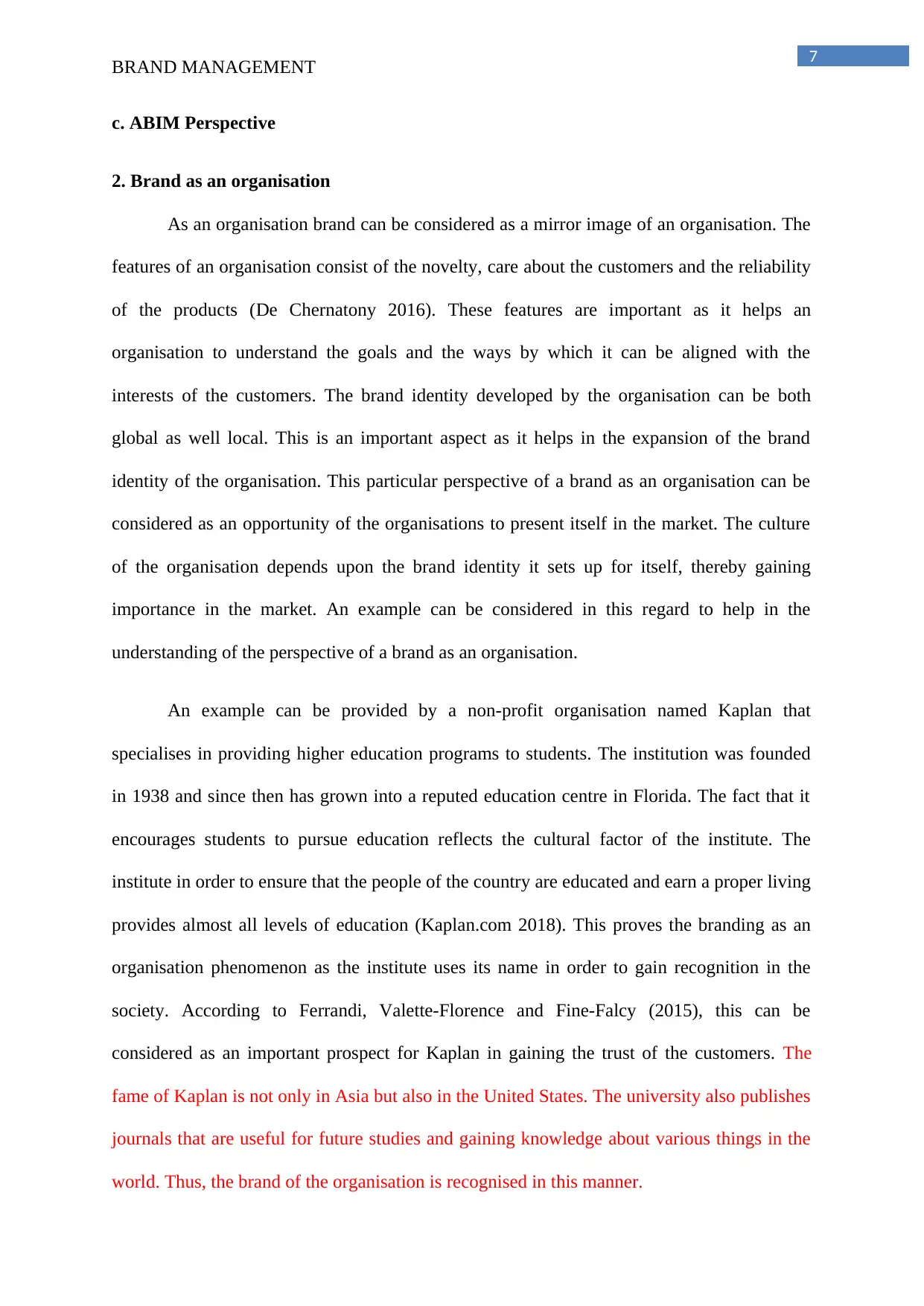
7
BRAND MANAGEMENT
c. ABIM Perspective
2. Brand as an organisation
As an organisation brand can be considered as a mirror image of an organisation. The
features of an organisation consist of the novelty, care about the customers and the reliability
of the products (De Chernatony 2016). These features are important as it helps an
organisation to understand the goals and the ways by which it can be aligned with the
interests of the customers. The brand identity developed by the organisation can be both
global as well local. This is an important aspect as it helps in the expansion of the brand
identity of the organisation. This particular perspective of a brand as an organisation can be
considered as an opportunity of the organisations to present itself in the market. The culture
of the organisation depends upon the brand identity it sets up for itself, thereby gaining
importance in the market. An example can be considered in this regard to help in the
understanding of the perspective of a brand as an organisation.
An example can be provided by a non-profit organisation named Kaplan that
specialises in providing higher education programs to students. The institution was founded
in 1938 and since then has grown into a reputed education centre in Florida. The fact that it
encourages students to pursue education reflects the cultural factor of the institute. The
institute in order to ensure that the people of the country are educated and earn a proper living
provides almost all levels of education (Kaplan.com 2018). This proves the branding as an
organisation phenomenon as the institute uses its name in order to gain recognition in the
society. According to Ferrandi, Valette-Florence and Fine-Falcy (2015), this can be
considered as an important prospect for Kaplan in gaining the trust of the customers. The
fame of Kaplan is not only in Asia but also in the United States. The university also publishes
journals that are useful for future studies and gaining knowledge about various things in the
world. Thus, the brand of the organisation is recognised in this manner.
BRAND MANAGEMENT
c. ABIM Perspective
2. Brand as an organisation
As an organisation brand can be considered as a mirror image of an organisation. The
features of an organisation consist of the novelty, care about the customers and the reliability
of the products (De Chernatony 2016). These features are important as it helps an
organisation to understand the goals and the ways by which it can be aligned with the
interests of the customers. The brand identity developed by the organisation can be both
global as well local. This is an important aspect as it helps in the expansion of the brand
identity of the organisation. This particular perspective of a brand as an organisation can be
considered as an opportunity of the organisations to present itself in the market. The culture
of the organisation depends upon the brand identity it sets up for itself, thereby gaining
importance in the market. An example can be considered in this regard to help in the
understanding of the perspective of a brand as an organisation.
An example can be provided by a non-profit organisation named Kaplan that
specialises in providing higher education programs to students. The institution was founded
in 1938 and since then has grown into a reputed education centre in Florida. The fact that it
encourages students to pursue education reflects the cultural factor of the institute. The
institute in order to ensure that the people of the country are educated and earn a proper living
provides almost all levels of education (Kaplan.com 2018). This proves the branding as an
organisation phenomenon as the institute uses its name in order to gain recognition in the
society. According to Ferrandi, Valette-Florence and Fine-Falcy (2015), this can be
considered as an important prospect for Kaplan in gaining the trust of the customers. The
fame of Kaplan is not only in Asia but also in the United States. The university also publishes
journals that are useful for future studies and gaining knowledge about various things in the
world. Thus, the brand of the organisation is recognised in this manner.
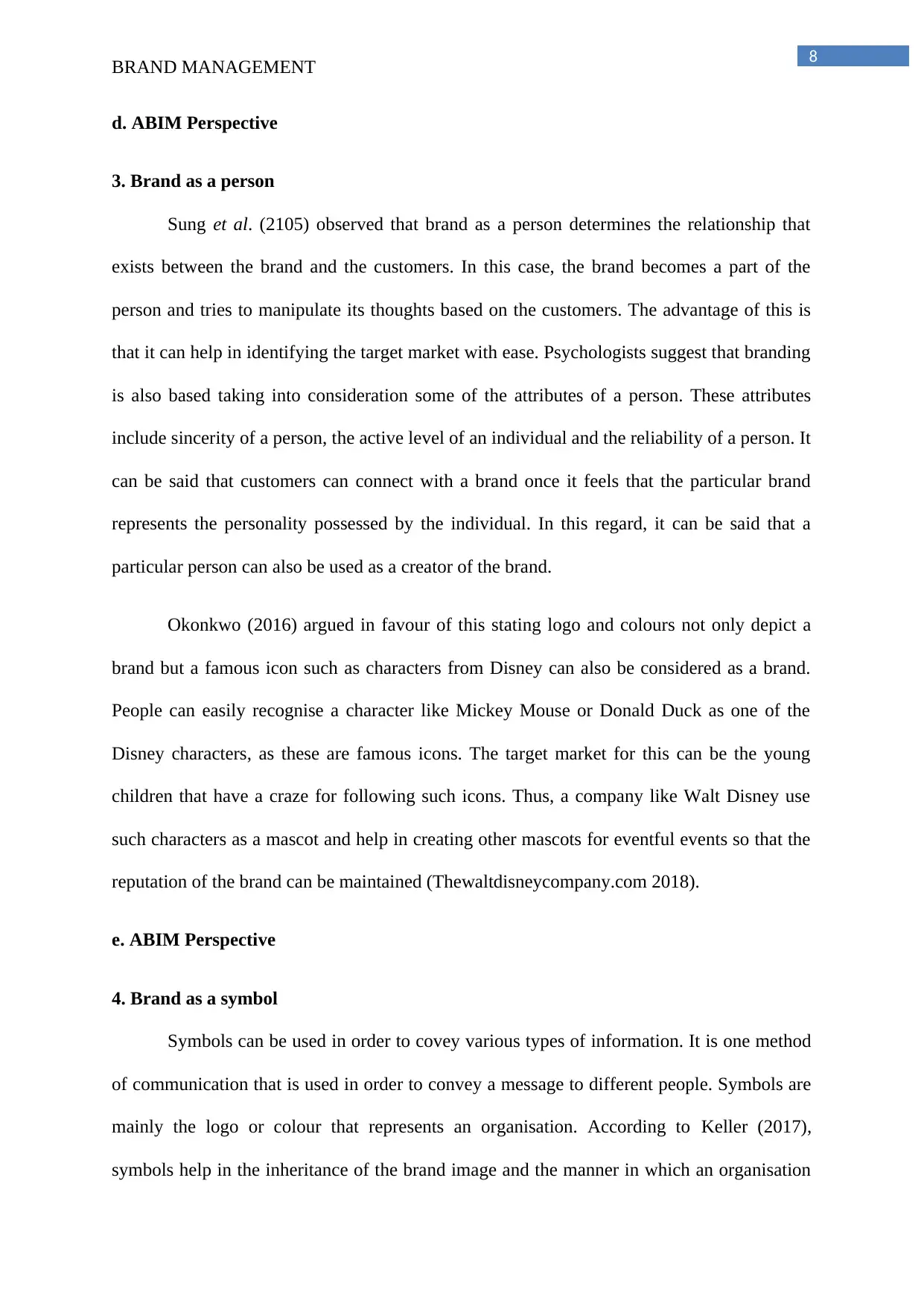
8
BRAND MANAGEMENT
d. ABIM Perspective
3. Brand as a person
Sung et al. (2105) observed that brand as a person determines the relationship that
exists between the brand and the customers. In this case, the brand becomes a part of the
person and tries to manipulate its thoughts based on the customers. The advantage of this is
that it can help in identifying the target market with ease. Psychologists suggest that branding
is also based taking into consideration some of the attributes of a person. These attributes
include sincerity of a person, the active level of an individual and the reliability of a person. It
can be said that customers can connect with a brand once it feels that the particular brand
represents the personality possessed by the individual. In this regard, it can be said that a
particular person can also be used as a creator of the brand.
Okonkwo (2016) argued in favour of this stating logo and colours not only depict a
brand but a famous icon such as characters from Disney can also be considered as a brand.
People can easily recognise a character like Mickey Mouse or Donald Duck as one of the
Disney characters, as these are famous icons. The target market for this can be the young
children that have a craze for following such icons. Thus, a company like Walt Disney use
such characters as a mascot and help in creating other mascots for eventful events so that the
reputation of the brand can be maintained (Thewaltdisneycompany.com 2018).
e. ABIM Perspective
4. Brand as a symbol
Symbols can be used in order to covey various types of information. It is one method
of communication that is used in order to convey a message to different people. Symbols are
mainly the logo or colour that represents an organisation. According to Keller (2017),
symbols help in the inheritance of the brand image and the manner in which an organisation
BRAND MANAGEMENT
d. ABIM Perspective
3. Brand as a person
Sung et al. (2105) observed that brand as a person determines the relationship that
exists between the brand and the customers. In this case, the brand becomes a part of the
person and tries to manipulate its thoughts based on the customers. The advantage of this is
that it can help in identifying the target market with ease. Psychologists suggest that branding
is also based taking into consideration some of the attributes of a person. These attributes
include sincerity of a person, the active level of an individual and the reliability of a person. It
can be said that customers can connect with a brand once it feels that the particular brand
represents the personality possessed by the individual. In this regard, it can be said that a
particular person can also be used as a creator of the brand.
Okonkwo (2016) argued in favour of this stating logo and colours not only depict a
brand but a famous icon such as characters from Disney can also be considered as a brand.
People can easily recognise a character like Mickey Mouse or Donald Duck as one of the
Disney characters, as these are famous icons. The target market for this can be the young
children that have a craze for following such icons. Thus, a company like Walt Disney use
such characters as a mascot and help in creating other mascots for eventful events so that the
reputation of the brand can be maintained (Thewaltdisneycompany.com 2018).
e. ABIM Perspective
4. Brand as a symbol
Symbols can be used in order to covey various types of information. It is one method
of communication that is used in order to convey a message to different people. Symbols are
mainly the logo or colour that represents an organisation. According to Keller (2017),
symbols help in the inheritance of the brand image and the manner in which an organisation
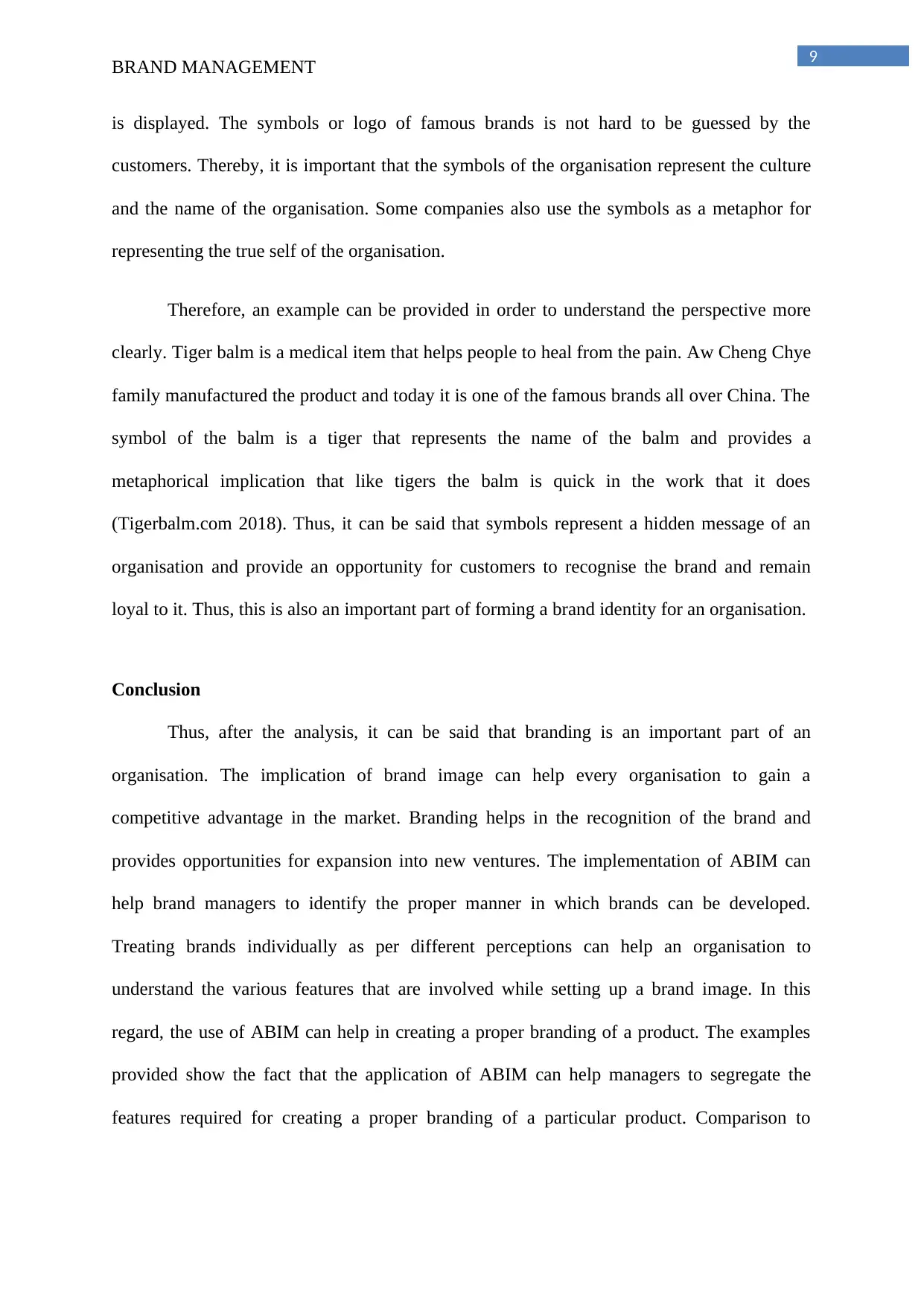
9
BRAND MANAGEMENT
is displayed. The symbols or logo of famous brands is not hard to be guessed by the
customers. Thereby, it is important that the symbols of the organisation represent the culture
and the name of the organisation. Some companies also use the symbols as a metaphor for
representing the true self of the organisation.
Therefore, an example can be provided in order to understand the perspective more
clearly. Tiger balm is a medical item that helps people to heal from the pain. Aw Cheng Chye
family manufactured the product and today it is one of the famous brands all over China. The
symbol of the balm is a tiger that represents the name of the balm and provides a
metaphorical implication that like tigers the balm is quick in the work that it does
(Tigerbalm.com 2018). Thus, it can be said that symbols represent a hidden message of an
organisation and provide an opportunity for customers to recognise the brand and remain
loyal to it. Thus, this is also an important part of forming a brand identity for an organisation.
Conclusion
Thus, after the analysis, it can be said that branding is an important part of an
organisation. The implication of brand image can help every organisation to gain a
competitive advantage in the market. Branding helps in the recognition of the brand and
provides opportunities for expansion into new ventures. The implementation of ABIM can
help brand managers to identify the proper manner in which brands can be developed.
Treating brands individually as per different perceptions can help an organisation to
understand the various features that are involved while setting up a brand image. In this
regard, the use of ABIM can help in creating a proper branding of a product. The examples
provided show the fact that the application of ABIM can help managers to segregate the
features required for creating a proper branding of a particular product. Comparison to
BRAND MANAGEMENT
is displayed. The symbols or logo of famous brands is not hard to be guessed by the
customers. Thereby, it is important that the symbols of the organisation represent the culture
and the name of the organisation. Some companies also use the symbols as a metaphor for
representing the true self of the organisation.
Therefore, an example can be provided in order to understand the perspective more
clearly. Tiger balm is a medical item that helps people to heal from the pain. Aw Cheng Chye
family manufactured the product and today it is one of the famous brands all over China. The
symbol of the balm is a tiger that represents the name of the balm and provides a
metaphorical implication that like tigers the balm is quick in the work that it does
(Tigerbalm.com 2018). Thus, it can be said that symbols represent a hidden message of an
organisation and provide an opportunity for customers to recognise the brand and remain
loyal to it. Thus, this is also an important part of forming a brand identity for an organisation.
Conclusion
Thus, after the analysis, it can be said that branding is an important part of an
organisation. The implication of brand image can help every organisation to gain a
competitive advantage in the market. Branding helps in the recognition of the brand and
provides opportunities for expansion into new ventures. The implementation of ABIM can
help brand managers to identify the proper manner in which brands can be developed.
Treating brands individually as per different perceptions can help an organisation to
understand the various features that are involved while setting up a brand image. In this
regard, the use of ABIM can help in creating a proper branding of a product. The examples
provided show the fact that the application of ABIM can help managers to segregate the
features required for creating a proper branding of a particular product. Comparison to
Secure Best Marks with AI Grader
Need help grading? Try our AI Grader for instant feedback on your assignments.
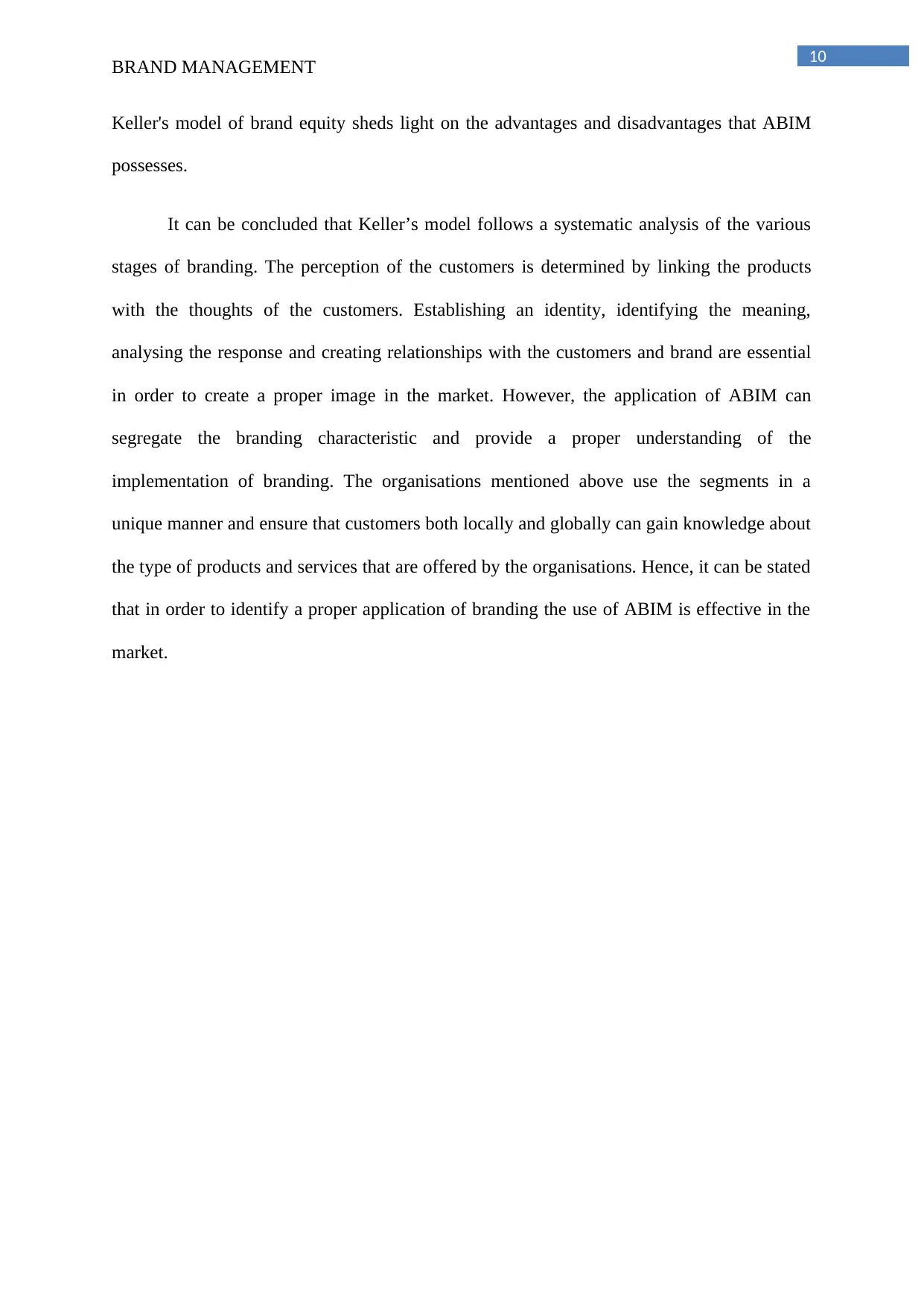
10
BRAND MANAGEMENT
Keller's model of brand equity sheds light on the advantages and disadvantages that ABIM
possesses.
It can be concluded that Keller’s model follows a systematic analysis of the various
stages of branding. The perception of the customers is determined by linking the products
with the thoughts of the customers. Establishing an identity, identifying the meaning,
analysing the response and creating relationships with the customers and brand are essential
in order to create a proper image in the market. However, the application of ABIM can
segregate the branding characteristic and provide a proper understanding of the
implementation of branding. The organisations mentioned above use the segments in a
unique manner and ensure that customers both locally and globally can gain knowledge about
the type of products and services that are offered by the organisations. Hence, it can be stated
that in order to identify a proper application of branding the use of ABIM is effective in the
market.
BRAND MANAGEMENT
Keller's model of brand equity sheds light on the advantages and disadvantages that ABIM
possesses.
It can be concluded that Keller’s model follows a systematic analysis of the various
stages of branding. The perception of the customers is determined by linking the products
with the thoughts of the customers. Establishing an identity, identifying the meaning,
analysing the response and creating relationships with the customers and brand are essential
in order to create a proper image in the market. However, the application of ABIM can
segregate the branding characteristic and provide a proper understanding of the
implementation of branding. The organisations mentioned above use the segments in a
unique manner and ensure that customers both locally and globally can gain knowledge about
the type of products and services that are offered by the organisations. Hence, it can be stated
that in order to identify a proper application of branding the use of ABIM is effective in the
market.
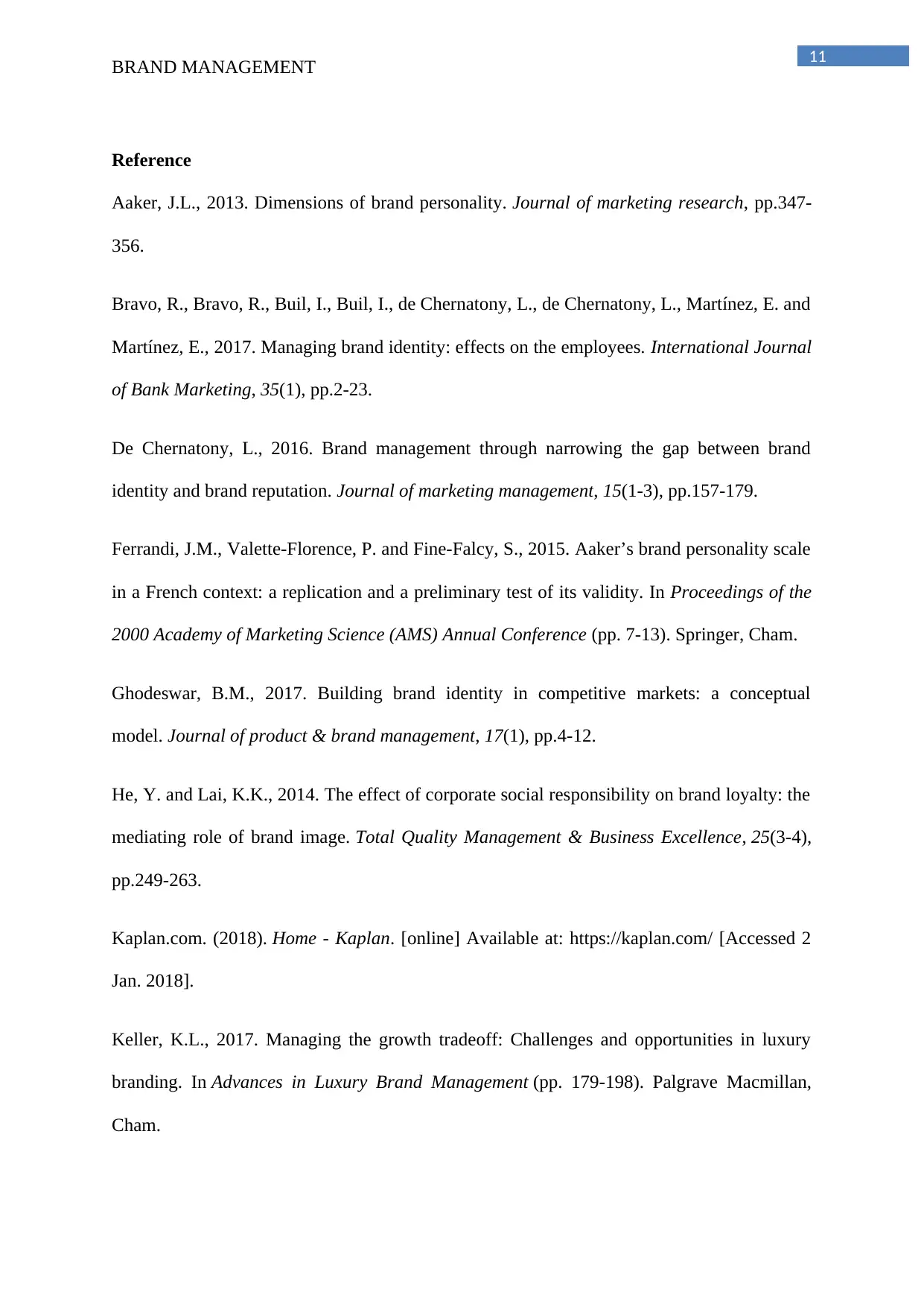
11
BRAND MANAGEMENT
Reference
Aaker, J.L., 2013. Dimensions of brand personality. Journal of marketing research, pp.347-
356.
Bravo, R., Bravo, R., Buil, I., Buil, I., de Chernatony, L., de Chernatony, L., Martínez, E. and
Martínez, E., 2017. Managing brand identity: effects on the employees. International Journal
of Bank Marketing, 35(1), pp.2-23.
De Chernatony, L., 2016. Brand management through narrowing the gap between brand
identity and brand reputation. Journal of marketing management, 15(1-3), pp.157-179.
Ferrandi, J.M., Valette-Florence, P. and Fine-Falcy, S., 2015. Aaker’s brand personality scale
in a French context: a replication and a preliminary test of its validity. In Proceedings of the
2000 Academy of Marketing Science (AMS) Annual Conference (pp. 7-13). Springer, Cham.
Ghodeswar, B.M., 2017. Building brand identity in competitive markets: a conceptual
model. Journal of product & brand management, 17(1), pp.4-12.
He, Y. and Lai, K.K., 2014. The effect of corporate social responsibility on brand loyalty: the
mediating role of brand image. Total Quality Management & Business Excellence, 25(3-4),
pp.249-263.
Kaplan.com. (2018). Home - Kaplan. [online] Available at: https://kaplan.com/ [Accessed 2
Jan. 2018].
Keller, K.L., 2017. Managing the growth tradeoff: Challenges and opportunities in luxury
branding. In Advances in Luxury Brand Management (pp. 179-198). Palgrave Macmillan,
Cham.
BRAND MANAGEMENT
Reference
Aaker, J.L., 2013. Dimensions of brand personality. Journal of marketing research, pp.347-
356.
Bravo, R., Bravo, R., Buil, I., Buil, I., de Chernatony, L., de Chernatony, L., Martínez, E. and
Martínez, E., 2017. Managing brand identity: effects on the employees. International Journal
of Bank Marketing, 35(1), pp.2-23.
De Chernatony, L., 2016. Brand management through narrowing the gap between brand
identity and brand reputation. Journal of marketing management, 15(1-3), pp.157-179.
Ferrandi, J.M., Valette-Florence, P. and Fine-Falcy, S., 2015. Aaker’s brand personality scale
in a French context: a replication and a preliminary test of its validity. In Proceedings of the
2000 Academy of Marketing Science (AMS) Annual Conference (pp. 7-13). Springer, Cham.
Ghodeswar, B.M., 2017. Building brand identity in competitive markets: a conceptual
model. Journal of product & brand management, 17(1), pp.4-12.
He, Y. and Lai, K.K., 2014. The effect of corporate social responsibility on brand loyalty: the
mediating role of brand image. Total Quality Management & Business Excellence, 25(3-4),
pp.249-263.
Kaplan.com. (2018). Home - Kaplan. [online] Available at: https://kaplan.com/ [Accessed 2
Jan. 2018].
Keller, K.L., 2017. Managing the growth tradeoff: Challenges and opportunities in luxury
branding. In Advances in Luxury Brand Management (pp. 179-198). Palgrave Macmillan,
Cham.
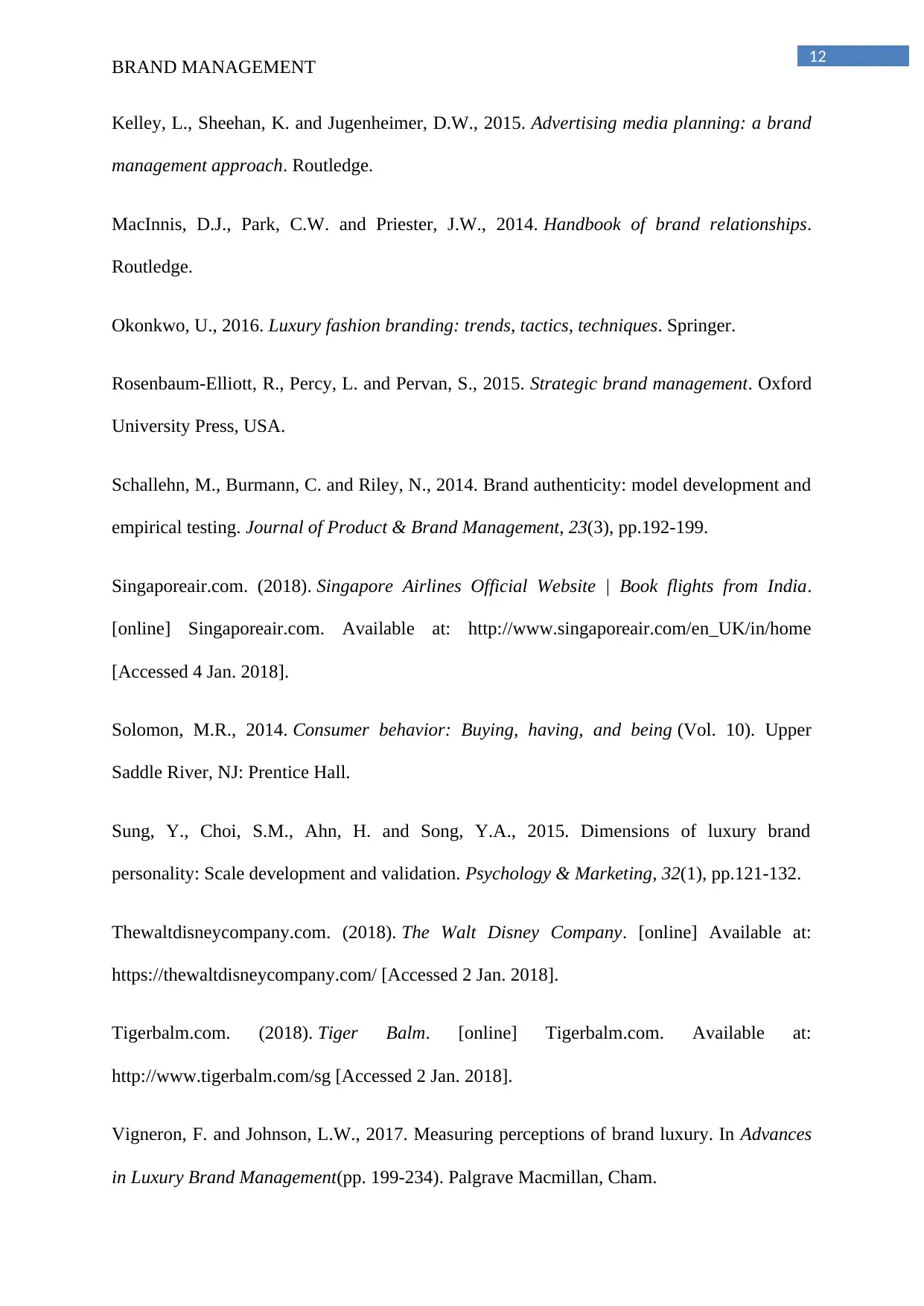
12
BRAND MANAGEMENT
Kelley, L., Sheehan, K. and Jugenheimer, D.W., 2015. Advertising media planning: a brand
management approach. Routledge.
MacInnis, D.J., Park, C.W. and Priester, J.W., 2014. Handbook of brand relationships.
Routledge.
Okonkwo, U., 2016. Luxury fashion branding: trends, tactics, techniques. Springer.
Rosenbaum-Elliott, R., Percy, L. and Pervan, S., 2015. Strategic brand management. Oxford
University Press, USA.
Schallehn, M., Burmann, C. and Riley, N., 2014. Brand authenticity: model development and
empirical testing. Journal of Product & Brand Management, 23(3), pp.192-199.
Singaporeair.com. (2018). Singapore Airlines Official Website | Book flights from India.
[online] Singaporeair.com. Available at: http://www.singaporeair.com/en_UK/in/home
[Accessed 4 Jan. 2018].
Solomon, M.R., 2014. Consumer behavior: Buying, having, and being (Vol. 10). Upper
Saddle River, NJ: Prentice Hall.
Sung, Y., Choi, S.M., Ahn, H. and Song, Y.A., 2015. Dimensions of luxury brand
personality: Scale development and validation. Psychology & Marketing, 32(1), pp.121-132.
Thewaltdisneycompany.com. (2018). The Walt Disney Company. [online] Available at:
https://thewaltdisneycompany.com/ [Accessed 2 Jan. 2018].
Tigerbalm.com. (2018). Tiger Balm. [online] Tigerbalm.com. Available at:
http://www.tigerbalm.com/sg [Accessed 2 Jan. 2018].
Vigneron, F. and Johnson, L.W., 2017. Measuring perceptions of brand luxury. In Advances
in Luxury Brand Management(pp. 199-234). Palgrave Macmillan, Cham.
BRAND MANAGEMENT
Kelley, L., Sheehan, K. and Jugenheimer, D.W., 2015. Advertising media planning: a brand
management approach. Routledge.
MacInnis, D.J., Park, C.W. and Priester, J.W., 2014. Handbook of brand relationships.
Routledge.
Okonkwo, U., 2016. Luxury fashion branding: trends, tactics, techniques. Springer.
Rosenbaum-Elliott, R., Percy, L. and Pervan, S., 2015. Strategic brand management. Oxford
University Press, USA.
Schallehn, M., Burmann, C. and Riley, N., 2014. Brand authenticity: model development and
empirical testing. Journal of Product & Brand Management, 23(3), pp.192-199.
Singaporeair.com. (2018). Singapore Airlines Official Website | Book flights from India.
[online] Singaporeair.com. Available at: http://www.singaporeair.com/en_UK/in/home
[Accessed 4 Jan. 2018].
Solomon, M.R., 2014. Consumer behavior: Buying, having, and being (Vol. 10). Upper
Saddle River, NJ: Prentice Hall.
Sung, Y., Choi, S.M., Ahn, H. and Song, Y.A., 2015. Dimensions of luxury brand
personality: Scale development and validation. Psychology & Marketing, 32(1), pp.121-132.
Thewaltdisneycompany.com. (2018). The Walt Disney Company. [online] Available at:
https://thewaltdisneycompany.com/ [Accessed 2 Jan. 2018].
Tigerbalm.com. (2018). Tiger Balm. [online] Tigerbalm.com. Available at:
http://www.tigerbalm.com/sg [Accessed 2 Jan. 2018].
Vigneron, F. and Johnson, L.W., 2017. Measuring perceptions of brand luxury. In Advances
in Luxury Brand Management(pp. 199-234). Palgrave Macmillan, Cham.
Paraphrase This Document
Need a fresh take? Get an instant paraphrase of this document with our AI Paraphraser

13
BRAND MANAGEMENT
Wheeler, A., 2017. Designing brand identity: an essential guide for the whole branding team.
John Wiley & Sons.
BRAND MANAGEMENT
Wheeler, A., 2017. Designing brand identity: an essential guide for the whole branding team.
John Wiley & Sons.
1 out of 14
Related Documents
Your All-in-One AI-Powered Toolkit for Academic Success.
+13062052269
info@desklib.com
Available 24*7 on WhatsApp / Email
![[object Object]](/_next/static/media/star-bottom.7253800d.svg)
Unlock your academic potential
© 2024 | Zucol Services PVT LTD | All rights reserved.





